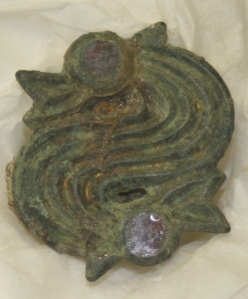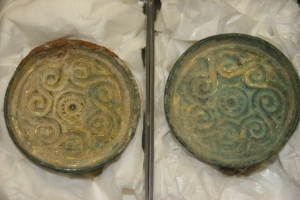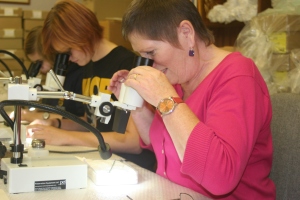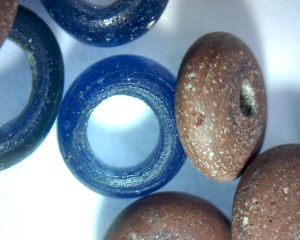Last week the Heritage Lottery Funded Eastbourne Ancestors project organised a series of conservation workshops run by CSI:Sittingbourne’s Dana Goodburn-Brown. You can find out more about her project here: www.anglosaxoncsi.wordpress.com
The sessions filled quickly with Dana working with 30 of the Eastbourne Museum Service volunteers over three and a half days. For the remainder of the week Dana showed me how to conserve different materials within the Museum collection.
The Tuesday before the workshops began, I showed Dana some of the artefacts from one of the main cemetery collections we are currently working on. The site is a high status Anglo-Saxon cemetery from Eastbourne known as ECAT which features in the Eastbourne Ancestors project along with all the other skeletons within the Eastbourne Museum Service collection. You can find out more about the Eastbourne Ancestors project here and how to get involved: www.facebook.com/EastbourneAncestors and email me at hayley dot forsyth at eastbourne dot gov dot uk.
Dana began the workshops by telling us about her career as a conservator and introducing her project; CSI:Sittingbourne, which is partnered with the Canterbury Archaeological Trust and Sittingbourne Museum. CSI:Sittingbourne recently won a prestigious International conservation award for their work within the community. The Sittingbourne dig was a rescue excavation to recover Anglo-Saxon material in an area called The Meads that was thought to have no archaeological importance.
It was noted by Dana how similar The Meads cemetery and ECAT are, both sites span the 5th-7th Centuries, have sword burials, and fine grave goods. The Meads, a large cemetery with 229 graves, discovered in 2008, has more ‘Warrior’ type burials than ECAT, which has approximately 192 burials. The ECAT cemetery has more surviving skeletal remains, but not as many graves, this is due to the geology and soil PH of the area.
The volunteers began by looking at several of the ECAT Eastbourne Ancestors grave goods under the microscopes. It was great to see the artefacts up close and Dana pointed out tool marks (which are like fingerprints in that you can sometimes identify the tool and production methods), evidence of gilding, decoration and remnants of textiles. I can’t wait to look at some of the teeth and skeletal pathology under the microscopes too, but that’s a topic for another blog post.
Then we moved onto more detailed microscope work, conserving thimbles, medals and buttons from a metal detectors bequest to the Eastbourne Museum Service. The collection of metal objects had been collated using tack which had left greasy residues and damaged some of the artefacts over time.
The volunteers worked on the metal items, using macroscopic (naked eye and magnifying glasses) and microscopic methods to see the difference in the levels of cleaning.
It was clear that the tack had leached the copper alloy colouring from the objects and Dana showed the volunteers under the microscope the evidence. You can see from the photo the tack pulled away from the object shows two colours; a turquoise green in the holes of the thimbles and the usual light blue colour of the tack that hadn’t touched the copper object.
Once the tack had been removed from the metal objects, they were then swabbed with acetone to remove any last traces of grease. Dana then explained to the volunteers the methods of conservation packing to protect the object and minimise the level of handling. Polyethylene zip lock bags were used packed with acid free tissue paper, later this will be updated with jiffy foam, a conservation material. The objects were placed in bags within the cushion of tissue, against the back of the bag so that the recorded details wouldn’t obscure the object. This means that the objects don’t have to be removed from the bags to see what they are and so should minimise damage through over handling.
The volunteers then worked on removing tape from pottery, which had been used by previous archaeologists to hold fragments together during post-excavation recording. The tape was carefully removed and the edges that had been covered were swabbed with acetone to remove any sticky residue. As these pieces fit together, Dana showed me how to conserve the pottery using special adhesive to stick the fragments and reconstruct the ceramics.
Dana has recently received an SEM (Scanning Electron Microscope) which takes very detailed images, from Oxford University. The Eastbourne Ancestors project is hoping to visit Dana and the CSI:Sittingbourne project to look at some of the grave goods using the SEM so we can see the evidence of textiles, tool marks and possible plant matter. It’s thought that some of the ECAT graves may have been left open and exposed for a period of time as insect casings were found within the soil. Dana explained that in some of The Meads graves straw and barley was used, barley being an aromatic, to possibly mask the smell of the decaying body.
Throughout the week Dana gave me advice and showed me how to look after the many artefacts. I have been re-generating and changing the silica gel, repackaging the artefacts and recording all the details so that I can produce a database of the objects and link the information to the skeletal data as the project progresses.


























Excellent overview and fabulous photos. What a great
blog!
Thanks!